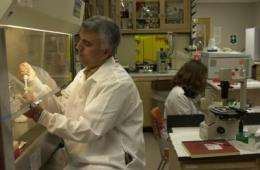Scientists use nanotechnology to hunt for hidden pathogens

Researchers at the University of Central Florida have developed a novel technique that may give doctors a faster and more sensitive tool to detect pathogens associated with inflammatory bowel disease, including Crohn's disease.
The new nanoparticle-based technique also may be used for detection of other microbes that have challenged scientists for centuries because they hide deep in human tissue and are able to reprogram cells to successfully evade the immune system.
The microbes reappear years later and can cause serious health problems such as seen in tuberculosis cases. Current testing methods to find these hidden microbes exist, but require a long time to complete and often delay effective treatment for weeks or even months.
UCF Associate Professor J. Manuel Perez and Professor Saleh Naser and their research team have developed a method using nanoparticles coated with DNA markers specific to the elusive pathogens. The technique is effective and more accurate than current methods at picking up even small amounts of a pathogen. More important, it takes hours instead of weeks or months to deliver results, potentially giving doctors a quicker tool to help patients.
"Our new technique has surpassed traditional molecular and microbiological methods," said Naser, a professor at the UCF College of Medicine. "Without compromising specificity or sensitivity, the nano-method produced reliable and accurate results within hours compared to months."
The group's translational research works is published in today's edition of the journal PLOS One.
The team created hybridizing magnetic relaxation nanosensors (hMRS) that can fish out and detect minuscule amounts of DNA from pathogens hiding within a patient's cells. The
hair-thin hMRS are composed of a polymer-coated iron oxide nanoparticle and are chemically modified to specifically bind to a DNA marker that is unique to a particular pathogen.
When the hMRS bind to the pathogen's DNA, a magnetic resonance signal is detected, which is amplified by the water molecules that surround the nanoparticle. Then the researcher can read the change in the magnetic signature on a computer screen or portable electronic device, such as a smartphone, and determine whether the sample is infected with a particular pathogen.
The researchers used Mycobacterium avium spp. paratuberculosis (MAP), a pathogen that has been implicated in the cause of Johne's disease in cattle and Crohn's disease in humans, to test out their technique. They used a large number of blood and biopsy tissue samples from patients with Crohn's disease and meat samples from cattle with Johne's disease.
"It is all about giving medical professionals easy and reliable tools to better understand the spread of a disease, while helping people get treatment faster," said Perez, who works at UCF's Nanoscience Technology Center. "That's my goal. And that's where nanotechnology really has a lot to offer, particularly when the technology has been validated using clinical, food and environmental samples as is in our case."
The National Institute of General Medical Sciences (NIGMS), which is a part of the National Institutes of Health, and funded the research, said this kind of basic research can provide the foundation for medical breakthroughs.
"Just last year, Dr. Perez and his team unexpectedly discovered the DNA binding property of their magnetic nanosensors, and now they have shown that it may become the basis for a rapid, sensitive lab test for hard-to-measure bacteria and viruses in patient samples," said Janna Wehrle, Ph.D., of NIGMS. "This is a wonderful example of how quickly an advance can move from the research bench to meet an important clinical need."
More information: Paper online: http://dx.plos.org/10.1371/journal.pone.0035326
Provided by University of Central Florida

















